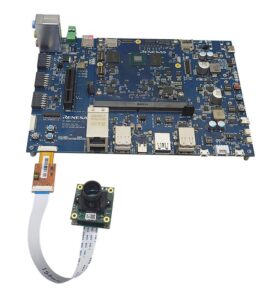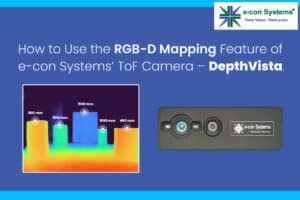Cameras and Sensors for Embedded Vision
WHILE ANALOG CAMERAS ARE STILL USED IN MANY VISION SYSTEMS, THIS SECTION FOCUSES ON DIGITAL IMAGE SENSORS
While analog cameras are still used in many vision systems, this section focuses on digital image sensors—usually either a CCD or CMOS sensor array that operates with visible light. However, this definition shouldn’t constrain the technology analysis, since many vision systems can also sense other types of energy (IR, sonar, etc.).
The camera housing has become the entire chassis for a vision system, leading to the emergence of “smart cameras” with all of the electronics integrated. By most definitions, a smart camera supports computer vision, since the camera is capable of extracting application-specific information. However, as both wired and wireless networks get faster and cheaper, there still may be reasons to transmit pixel data to a central location for storage or extra processing.
A classic example is cloud computing using the camera on a smartphone. The smartphone could be considered a “smart camera” as well, but sending data to a cloud-based computer may reduce the processing performance required on the mobile device, lowering cost, power, weight, etc. For a dedicated smart camera, some vendors have created chips that integrate all of the required features.
Cameras
Until recent times, many people would imagine a camera for computer vision as the outdoor security camera shown in this picture. There are countless vendors supplying these products, and many more supplying indoor cameras for industrial applications. Don’t forget about simple USB cameras for PCs. And don’t overlook the billion or so cameras embedded in the mobile phones of the world. These cameras’ speed and quality have risen dramatically—supporting 10+ mega-pixel sensors with sophisticated image processing hardware.
Consider, too, another important factor for cameras—the rapid adoption of 3D imaging using stereo optics, time-of-flight and structured light technologies. Trendsetting cell phones now even offer this technology, as do latest-generation game consoles. Look again at the picture of the outdoor camera and consider how much change is about to happen to computer vision markets as new camera technologies becomes pervasive.
Sensors
Charge-coupled device (CCD) sensors have some advantages over CMOS image sensors, mainly because the electronic shutter of CCDs traditionally offers better image quality with higher dynamic range and resolution. However, CMOS sensors now account for more 90% of the market, heavily influenced by camera phones and driven by the technology’s lower cost, better integration and speed.

“A Lightweight Camera Stack for Edge AI,” a Presentation from Meta
Jui Garagate, Camera Software Engineer, and Karthick Kumaran, Staff Software Engineer, both of Meta, co-present the “Lightweight Camera Stack for Edge AI” tutorial at the May 2025 Embedded Vision Summit. Electronic products for virtual and augmented reality, home robots and cars deploy multiple cameras for computer vision and AI use… “A Lightweight Camera Stack for

ImagingNext 2025 Inspires the AI Vision Community: Exciting Insights, Powerful Keynote Speeches, and Valuable Contacts
Munich, Bavaria, Germany – September 25th, 2025 – This year’s ImagingNext, the leading event for AI vision and embedded imaging, was a resounding success. Around 100 participants came together to discuss the latest trends, technologies, and use cases in the field of vision AI in an inspiring atmosphere. The mood was great – from the

How e-con Systems Built a Multi-camera Solution for Large Mining Vehicles to Eliminate Blind Spots
This blog post was originally published at e-con Systems’ website. It is reprinted here with the permission of e-con Systems. Large mining vehicles tend to operate in unpredictable terrains. They often face issues like poor lighting or heavy dust. Find out how e-con Systems helped a client select and deploy a multi-camera solution for their

Semiconductors at the Heart of Automotive’s Next Chapter
This market research report was originally published at the Yole Group’s website. It is reprinted here with the permission of the Yole Group. Automotive White Paper, Vol.2, Powered by Yole Group – Shifting gears! KEY TAKEAWAYS The automotive semiconductor market will soar from $68 billion in 2024 to $132 billion in 2030, growing at a

e-con Systems Expands Camera Support for Renesas’ New RZ/G3E, Enabling Reliable Edge AI Vision Solutions
California & Chennai (Aug 27, 2025) – e-con Systems®, a leading embedded vision solutions provider, announces camera support for Renesas’ latest RZ/G3E microprocessor, strengthening its partnership with Renesas in powering next-generation embedded vision applications such as industrial automation, smart city, automotive and more. Building on our successful integration with Renesas’ RZ/V2N and RZ/V2H processors, e-con

FRAMOS Extends D400e 3D Camera Support to NVIDIA Holoscan Sensor Bridge
Industrial-grade depth sensing now integrates seamlessly with edge AI pipelines on NVIDIA Jetson AGX Orin and Jetson AGX Thor Munich, Bavaria, Germany – September 17, 2025.– FRAMOS announces official support for NVIDIA Holoscan Sensor Bridge on its D400e series of industrial 3D depth cameras, enabling seamless integration of RealSense™-based stereo vision into advanced edge AI

How to Use the RGB-D Mapping Feature of e-con Systems’ DepthVista ToF Camera
This blog post was originally published at e-con Systems’ website. It is reprinted here with the permission of e-con Systems. Learn how to leverage the RGB-D mapping feature of e-con Systems’ DepthVista ToF camera to align RGB and depth data for precise 3D vision applications. This step-by-step guide covers camera calibration, the role of intrinsic

“Specifying and Designing Cameras for Computer Vision Applications,” a Presentation from Etron Technology America
Richard Crisp, Vice President and CTO at Etron Technology America, presents the “Specifying and Designing Cameras for Computer Vision Applications” tutorial at the May 2025 Embedded Vision Summit. Designing a camera system requires a deep understanding of the fundamental principles of image formation and the physical characteristics of its components.… “Specifying and Designing Cameras for

“Enabling Ego Vision Applications on Smart Eyewear Devices,” a Presentation from EssilorLuxottica
Francesca Palermo, Research Principal Investigator at EssilorLuxottica, presents the “Enabling Ego Vision Applications on Smart Eyewear Devices” tutorial at the May 2025 Embedded Vision Summit. Ego vision technology is revolutionizing the capabilities of smart eyewear, enabling applications that understand user actions, estimate human pose and provide spatial awareness through simultaneous… “Enabling Ego Vision Applications on

“Deep Sentinel: Lessons Learned Building, Operating and Scaling an Edge AI Computer Vision Company,” a Presentation from Deep Sentinel
David Selinger, CEO of Deep Sentinel, presents the “Deep Sentinel: Lessons Learned Building, Operating and Scaling an Edge AI Computer Vision Company” tutorial at the May 2025 Embedded Vision Summit. Deep Sentinel’s edge AI security cameras stop some 45,000 crimes per year. Unlike most security camera systems, they don’t just… “Deep Sentinel: Lessons Learned Building,

